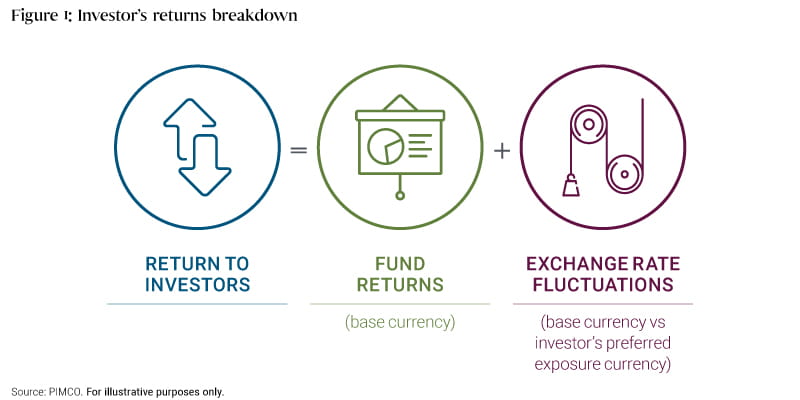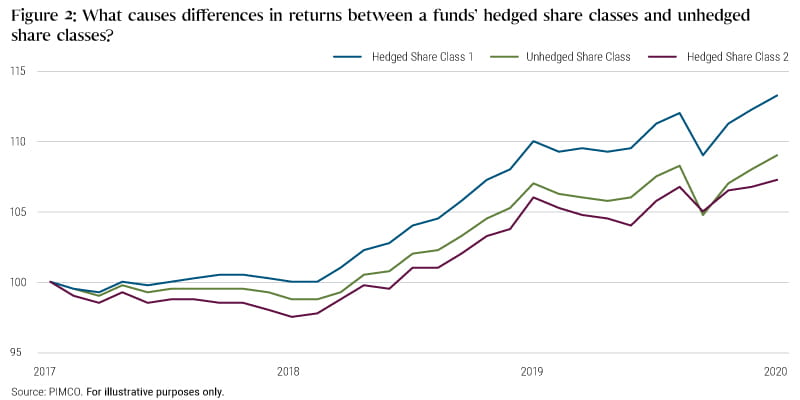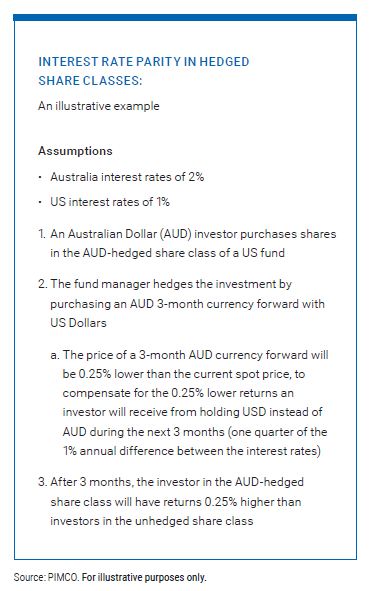Understanding Hedged Share Classes
Hedged share classes can be a useful tool for mutual fund investors to gain exposure to assets denominated in foreign currencies, without taking on the full accompanying currency risk. Where available, they can allow investors to effectively make independent decisions on which assets they want exposure to, and which currencies they want exposure to. While hedged share classes can be a powerful part of an investor’s toolkit, they are designed to minimise, but not completely eliminate, the risk of currency fluctuations.
WHAT ARE HEDGED SHARE CLASSES?
Hedged share classes seek to minimise, but cannot completely eliminate, a fund investor’s currency risk. Specifically, they aim to reduce the impact of exchange rate fluctuations between the fund’s base currency and the investor’s preferred currency of exposure.
At a high level, a fund investor’s returns can be broken out into the below components (Figure 1). The goal of a hedged share class is to minimise the final part of that equation. For example, a UK-based investor seeking to gain exposure to the US bond market, but wanting to minimise exposure to exchange rate fluctuations between the US Dollar (USD) and the British Pound (GBP), could purchase the GBP-hedged share class of a US bond fund. A variety of hedging approaches, including multi-currency hedging and partial hedging, can be used to pursue a variety of different goals, but this note will focus on the most common form of hedged share classes.

WHAT ARE SOME REASONS INVESTORS USE HEDGED SHARE CLASSES?
- Minimise unwanted exposure to a foreign currency: Investors often seek to gain exposure to assets outside their local markets for the diversification benefits, but do not wish to expose themselves to additional currency risk that these assets may bring.
- Reduce complexity: Administering a currency hedging programme can be complex, and is something many investors would prefer not to do themselves.
- Convenience: Hedge share classes may allow investors to purchase fund shares in their preferred currencies instead of having to pay for shares in the fund’s base currency.
HOW DO HEDGED SHARE CLASSES WORK?
1. An investor purchases shares of a hedged share class in the hedging currency
2. The fund manager receives the investor’s funds, and as soon as possible will engage in two currency transactions:
- Converts the investor’s funds from the hedging currency into the fund’s base currency, which can be used to purchase assets for the fund. This is done at the spot foreign exchange rate.
- Hedges the investor’s currency exposure. This is most commonly done through a currency forward, which allows the fund manager to convert an agreed-upon amount of the fund’s base currency to the hedging currency, at a set price at a set date in the future. This set price is the forward foreign exchange rate. Importantly, only the value of the hedged share class is hedged, which means there will be no impact on the returns of the broader fund.
3. The fund manager will renew or “roll-over” the currency hedge on at least a monthly basis, updating it to reflect the current value of the underlying assets. The fund manager, however, may roll-over the hedge on a more frequent basis in periods of market volatility and when required by regulation.
4. When the investor wishes to redeem their shares in the fund, the fund manager will convert the fund’s base currency into the hedged currency, which will be distributed to the investor. The fund manager will also adjust the hedging level of the hedged share class.

WHAT CAUSES DIFFERENCES IN RETURNS BETWEEN A FUNDS’ HEDGED SHARE CLASSES AND UNHEDGED SHARE CLASSES?
- Interest rate differential: This can have a positive or negative impact on hedged share class returns. A hedged share class may have higher returns than the unhedged share class if the hedging currency’s interest rate is higher than the base currency’s interest rate. Conversely, a hedged share class may have lower returns than the unhedged share class if the hedging currency’s interest rate is lower than the base currency’s interest rate. This is because the pricing of the currency forwards used for hedging takes into account the different interest rates that investors would earn holding different currencies. These relationships are governed by an economic concept known as interest rate parity, (see illustrative example box) which broadly holds in most market environments.

- Cross currency basis: Like in any other market, the price of currency hedging contracts will be influenced by supply and demand. This is known as cross-currency basis, and can make hedging more or less expensive depending on market conditions.
- Unrealised profit and loss from the currency hedging contract: The value of the currency forward contract may rise or fall in value, but these gains or losses will remain unrealized until the contract is closed and cash is transferred. In the interim, unrealized gains or losses will be reflected in the value of the hedged share class, but will not actually be able to be reinvested by the fund manager, which could result in marginal dilution of both positive and negative performance compared to the unhedged share class.
- Transaction costs: There are small transaction costs from hedging that will only detract from the performance of the hedged share class. Transaction costs will likely be higher in periods of market volatility.
- Intraday currency volatility: Given the constantly moving nature of markets, it is impossible to perfectly currency hedge a share class. A hedged share class may have currency exposure for a short amount of time between when hedged share class shares were purchased and when the fund manager is able to enter into a hedging contract.
DO HEDGED SHARE CLASSES HAVE AN IMPACT ON OTHER INVESTORS IN THE FUND?
- All gains, losses, and transactions costs of hedging transactions are solely borne by the investors in the hedged share class.
- Counterparties of the hedged share class’ hedging transactions may have recourse to the assets of other share classes, but this would likely only be relevant in an extreme market scenario.
- Hedged share classes may provide some benefit to other investors, by allowing the fund’s investor base to be larger and more diverse, which may help mitigate disruption from concentrated fund redemption and purchase activity.
Disclosures
All investments contain risk and may lose value. Investing in the bond market is subject to risks, including market, interest rate, issuer, credit, inflation risk, and liquidity risk. The value of most bonds and bond strategies are impacted by changes in interest rates. Bonds and bond strategies with longer durations tend to be more sensitive and volatile than those with shorter durations; bond prices generally fall as interest rates rise, and low interest rate environments increase this risk. Reductions in bond counterparty capacity may contribute to decreased market liquidity and increased price volatility. Bond investments may be worth more or less than the original cost when redeemed. Currency rates may fluctuate significantly over short periods of time and may reduce the returns of a portfolio. Derivatives may involve certain costs and risks, such as liquidity, interest rate, market, credit, management and the risk that a position could not be closed when most advantageous. Investing in derivatives could lose more than the amount invested. Investing in foreign-denominated and/or -domiciled securities may involve heightened risk due to currency fluctuations, and economic and political risks, which may be enhanced in emerging markets.
The information contained herein is presented for illustrative purposes only and is not intended to represent any particular product or strategy’s performance or how any particular product or strategy will be invested or allocated at any particular time.
There is no guarantee that these investment strategies will work under all market conditions or are appropriate for all investors and each investor should evaluate their ability to invest long-term, especially during periods of downturn in the market. No representation is being made that any account, product, or strategy will or is likely to achieve profits, losses, or results similar to those shown.
This material contains the current opinions of the author but not necessarily those of PIMCO, and such opinions are subject to change without notice. This material is distributed for informational purposes only and should not be considered as investment advice or a recommendation of any particular security, strategy or investment product. Information contained herein has been obtained from sources believed to be reliable, but not guaranteed.
PIMCO as a general matter provides services to qualified institutions, financial intermediaries and institutional investors. Individual investors should contact their own financial professional to determine the most appropriate investment options for their financial situation. This is not an offer to any person in any jurisdiction where unlawful or unauthorized. | Pacific Investment Management Company LLC, 650 Newport Center Drive, Newport Beach, CA 92660 is regulated by the United States Securities and Exchange Commission. | PIMCO Europe Ltd (Company No. 2604517) and PIMCO Europe Ltd - Italy (Company No. 07533910969) are authorised and regulated by the Financial Conduct Authority (12 Endeavour Square, London E20 1JN) in the UK. The Italy branch is additionally regulated by the Commissione Nazionale per le Società e la Borsa (CONSOB) in accordance with Article 27 of the Italian Consolidated Financial Act. PIMCO Europe Ltd services are available only to professional clients as defined in the Financial Conduct Authority’s Handbook and are not available to individual investors, who should not rely on this communication. | PIMCO Deutschland GmbH (Company No. 192083, Seidlstr. 24-24a, 80335 Munich, Germany), PIMCO Deutschland GmbH Italian Branch (Company No. 10005170963) and PIMCO Deutschland GmbH Spanish Branch (N.I.F. W2765338E) are authorised and regulated by the German Federal Financial Supervisory Authority (BaFin) (Marie- Curie-Str. 24-28, 60439 Frankfurt am Main) in Germany in accordance with Section 32 of the German Banking Act (KWG). The Italian Branch and Spanish Branch are additionally supervised by the Commissione Nazionale per le Società e la Borsa (CONSOB) in accordance with Article 27 of the Italian Consolidated Financial Act and the Comisión Nacional del Mercado de Valores (CNMV) in accordance with obligations stipulated in articles 168 and 203 to 224, as well as obligations contained in Tile V, Section I of the Law on the Securities Market (LSM) and in articles 111, 114 and 117 of Royal Decree 217/2008, respectively. The services provided by PIMCO Deutschland GmbH are available only to professional clients as defined in Section 67 para. 2 German Securities Trading Act (WpHG). They are not available to individual investors, who should not rely on this communication. | PIMCO (Schweiz) GmbH (registered in Switzerland, Company No. CH-020.4.038.582-2), Brandschenkestrasse 41, 8002 Zurich, Switzerland, Tel: + 41 44 512 49 10. The services provided by PIMCO (Schweiz) GmbH are not available to individual investors, who should not rely on this communication but contact their financial adviser. | PIMCO Asia Pte Ltd (Registration No. 199804652K) is regulated by the Monetary Authority of Singapore as a holder of a capital markets services licence and an exempt financial adviser. The asset management services and investment products are not available to persons where provision of such services and products is unauthorised. | PIMCO Asia Limited is licensed by the Securities and Futures Commission for Types 1, 4 and 9 regulated activities under the Securities and Futures Ordinance. PIMCO Asia Limited is registered as a cross-border discretionary investment manager with the Financial Supervisory Commission of Korea (Registration No. 08-02-307). The asset management services and investment products are not available to persons where provision of such services and products is unauthorised. | PIMCO Australia Pty Ltd ABN 54 084 280 508, AFSL 246862. This publication has been prepared without taking into account the objectives, financial situation or needs of investors. Before making an investment decision, investors should obtain professional advice and consider whether the information contained herein is appropriate having regard to their objectives, financial situation and needs. | PIMCO Japan Ltd, Financial Instruments Business Registration Number is Director of Kanto Local Finance Bureau (Financial Instruments Firm) No. 382. PIMCO Japan Ltd is a member of Japan Investment Advisers Association and The Investment Trusts Association, Japan. All investments contain risk. There is no guarantee that the principal amount of the investment will be preserved, or that a certain return will be realized; the investment could suffer a loss. All profits and losses incur to the investor. The amounts, maximum amounts and calculation methodologies of each type of fee and expense and their total amounts will vary depending on the investment strategy, the status of investment performance, period of management and outstanding balance of assets and thus such fees and expenses cannot be set forth herein. | PIMCO Taiwan Limited is managed and operated independently. The reference number of business license of the company approved by the competent authority is (107) FSC SICE Reg. No.001. 40F., No.68, Sec. 5, Zhongxiao E. Rd., Xinyi Dist., Taipei City 110, Taiwan (R.O.C.), Tel: +886 2 8729-5500. | PIMCO Canada Corp. (199 Bay Street, Suite 2050, Commerce Court Station, P.O. Box 363, Toronto, ON, M5L 1G2) services and products may only be available in certain provinces or territories of Canada and only through dealers authorized for that purpose. | PIMCO Latin America Av. Brigadeiro Faria Lima 3477, Torre A, 5° andar São Paulo, Brazil 04538-133. | No part of this publication may be reproduced in any form, or referred to in any other publication, without express written permission. PIMCO is a trademark of Allianz Asset Management of America L.P. in the United States and throughout the world. ©2020, PIMCO.
